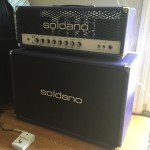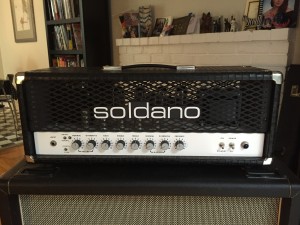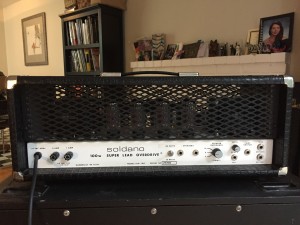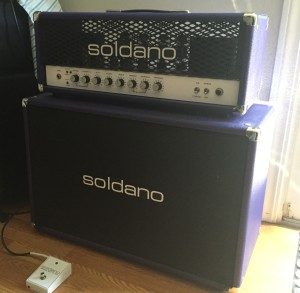 Michael Soldano had no intentions of becoming a guitar amp maker. Prior to the launch of the first Soldano Super Lead Overdrive (SLO), he dreamed of rock stardom and not amp building. But it was during these early days while he was on his tone quest that he realized he wasn’t fully satisfied with the amplifiers that were available at the time.
Michael Soldano had no intentions of becoming a guitar amp maker. Prior to the launch of the first Soldano Super Lead Overdrive (SLO), he dreamed of rock stardom and not amp building. But it was during these early days while he was on his tone quest that he realized he wasn’t fully satisfied with the amplifiers that were available at the time.
“I set out to build an amp for myself,” he said. “I wanted an amp that could provide a higher gain tone with sustain while keeping articulation at any volume. Marshall’s always needed volume to get the amp compression and tone really happening.”
Soldano started on the preamp of his amp, and built a unique compression circuit to give the preamp stage better control of the sustain itself. If you play the overdrive channel on a Soldano, you’ll note that even at lower preamp level settings of 3-4, there is still quite a bit of sustain to be had. It’s one of the unique sonic signatures of the Soldano that other amps seem to lack – especially on leads. And bumping up the overdrive gain control (Soldano’s personal sweet spot setting is at 7, mine is at 4), adds more low end overtones and compression, but the amp never becomes overly squashed – the articulation remains. Some players need to get used to this feature – you can’t hide because the distortion doesn’t blur in mud. This articulation is also a key sonic signature of the Soldano SLO.

Soldano carefully tuned and selected values of cathode and plate resistors and caps that reduced the gain in each stage of the individual preamp tubes in the circuit so they were not maxed out. This was backwards from what most people were doing when modding amps as they would push each preamp tube for max gain. Soldano instead added another two stages of gain to the circuit via an added preamp tube, but the trick was to not push the tubes to their limits and create any oversaturation.
Michael Soldano’s love and passion for working on hot rods and his understanding of the mechanics of automotive design translated into a passion for his own desire in wanting to ultimately build a better amplifier. Indeed even the look of the exposed front and rear grills of the Soldano SLO with glowing 5881/6L6 tubes seems influenced by automotive designs, harking to the visual of beautiful grill work and vents found on classic hotrods.
 Cosmetics aside, the primary goal of the SLO was getting the sonic tone he heard in his head. “Once I got the circuit dialed in for the Super Lead Overdrive, that’s when I realized other people actually might want one as well.”
Cosmetics aside, the primary goal of the SLO was getting the sonic tone he heard in his head. “Once I got the circuit dialed in for the Super Lead Overdrive, that’s when I realized other people actually might want one as well.”
And word spread, players plugged in, and the smooth, articulate hot rodded high-gain distorted tone of the ‘80s was born. Many of the hard rock players of the time were early adopters of the SLO, including notable names like Warren DeMartini, George Lynch, and of course Eddie Van Halen, but the SLO wasn’t limited to only hard rock players. Blues great Stevie Ray Vaughan took delivery of an SLO just before his tragic passing, and Warren Haynes remains a classic rock and blues genius playing licks through his SLO to this day.
While classic non-master volume amplifiers from Marshall needed volume to get the tone optimized due to transformer saturation and power tube compression, Soldano had a different concept in mind when creating the SLO. He chose to dial in the preamp stage for high gain with versatile and responsive tone controls, and then make a very high-fidelity power stage that could provide a wide frequency response. Having this high-fidelity power output stage mixed with a preamp stage that has extensive tone shaping capabilities are at the heart of the Soldano SLO design.
The power output tube stage was developed around the 5881/6L6 tube, a tube that does not compress like an EL34 used in a Marshall. The 5881/6L6 retains a full bottom end that is warm while providing plenty of top end response. Many great Fender amps were the influence in the tube choice, but Soldano still wanted something more.
That something more would be found in the transformers. In keeping with the demands for having a high-fidelity power output stage, DeYoung Manufacturing was commissioned to build the transformers for the SLO. The output transformer itself was custom designed by a DeYoung engineer based on Soldano’s guidance. “The output transformer is unique in lots of areas. The way it is potted, the capacitive elements and the way it is interleaved in its design are made so it gives a wide frequency response from the lows to highs but with none of the excessive high end fizz. The top end remains very smooth.”

The extra detail in the transformer design is one of the primary reasons why makers who may have copied Soldano’s ideas simply can’t get the same sonic characteristic qualities as the original Soldano SLO. The SLO is also built on a chassis that is meticulously wired with top quality components on thick through-hole PCBs. It ALL matters in the end result.
For player use and control, Soldano took a less-is-more approach to his design. He explained during his formative years that he spent time with Boogie amps. “They were very difficult to dial in and I didn’t like where the tone controls were placed in the circuit before the preamp stages. This didn’t make sense for the sound I was after and the low end was flubby,” he stated. “And then you had push-this and pull-that and lots of switches. I just wanted a great sound and play.”

So when building the SLO, he placed the tone circuit where he felt it worked best – post preamp gain – and then decided the controls and layout of the SLO should remain simple. “I’ve found that the more circuitry that the signal goes through, the worse it sounds.” He considered adding additional independent e.q. controls for each of the SLO’s two channels, but ultimately decided against it. “I was using the same settings whether I was on the Normal or Overdrive channels, so I just didn’t find it necessary.”
The design of the Soldano Super Lead Overdrive remains legendary, and even after nearly three decades in production it remains a relevant and highly musical tool. Soldano offers additional amps in his lineup that provide additional options to meet the tastes and budgets of various players, and at heart, they are all based on the SLO. If you want a single-channel stripped down SLO, get an Avenger. If you want additional control over the clean, crunch, and overdrive channels, you can go for the Decatone. For SLO tones on a budget, Soldano offers the Hot Rod series in 100 and 50 watt models. And with today’s players enjoying the tones from smaller wattage amps, Soldano now offers a Hot Rod 25 which even adds some additional tricks to the circuit that gives users a kind of technology with reduced voltages for “Brown Sound” type applications.
It’s easy to get caught up in much of the technology features, buzzwords and extras that today’s amps can offer. Extra channels, lots of buttons and footswitch control with MIDI and onboard digital signal processing, etc. But if your interests are in capturing great vacuum tube tone with a surprising range of tonal control and gain versatility, the pure circuit and quality build and components used in the Soldano SLO just might be the amp that can feel liberating to play through. Sometimes less really can be more.